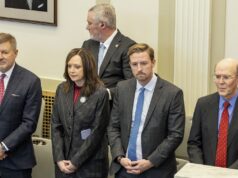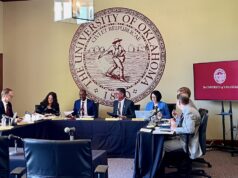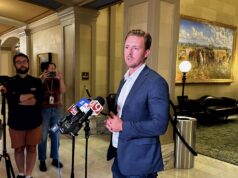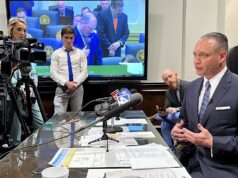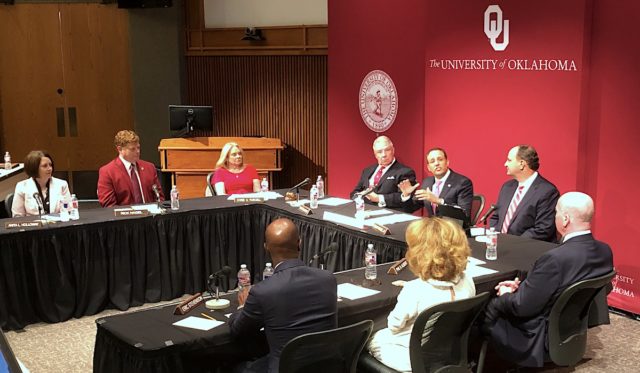

Hitch up the wagon and get some apples for the ponies — the University of Oklahoma’s athletic programs are headed to the SEC in 2025, if not earlier.
The OU Board of Regents voted unanimously today to join the University of Texas in leaving the Big 12 Conference for the powerful Southeastern Conference, which accepted the two schools’ request for membership Thursday. OU leaders did not take questions from more than a dozen members of the media present. Following the meeting, regents exited the OU Health Sciences Center auditorium behind a pair of velvet ropes. Some gathered for a catered lunch while others left the building.
OU leaders, Texas administrators and the SEC have all referred to an implementation date of July 1, 2025, the end of the current Big 12 TV contract. But it’s possible the incongruently named conference could disband early if some of its remaining eight members consider their own realignment alternatives. Or, the Big 12 may try to add new schools, which could also hasten the exit of OU and Texas.
“We are in an era of dramatic change and historic transformation. And it has happened at a pace that none of us has ever experienced,” said OU athletic director Joe Castiglione. “It became obvious that standing pat would mean falling behind. It would mean putting our program in a precarious position, both competitively and financially.”
The whirlwind development took only two weeks to move from possibility to reality, with OU’s decision to leave Oklahoma State University behind drawing the ire of some OSU alumni, fans and supporters. More than 30 state lawmakers signed a letter outlining their disappointment in OU’s decision.
“We are disappointed in the lack of transparency and making decisions of such magnitude at a time when the Oklahoma Legislature is out of session,” the letter read. “It is our desire to see collaboration and parity for our state’s two comprehensive institutions. Moving forward, we ask that you keep legislators and the public informed as this situation is of great importance to the state of Oklahoma.”
Friday, House Appropriations and Budget Chairman Mark McBride (R-Moore) exercised his legislative discretion to enter the OU board’s executive session, a closed-door portion of public meetings authorized by the Oklahoma Open Meeting Act. (He was not one of the lawmakers who signed the letter.)
“My questions were all answered,” McBride said after Friday’s meeting. “I’m very satisfied.”
The state statute that authorized McBride’s attendance of the executive session prevents him from discussion the board’s private conversation, but he did say he believes the bold change aligns with the university’s broader strategic plan and other major moves, such as the recent OU Health merger.
“It’s going to be different. It’ll be interesting,” McBride said. “I read an article the other day, and somebody said that by 2025 athletics will look totally different. I have to agree with that [because of] the name, image and likeness [development].”
OU President Joe Harroz also referenced the U.S. Supreme Court decision that functionally authorized states to create guidelines for collegiate athletes to profit financially off of licensing their name, image and likeness. Harroz, who began his tenure at OU as former President David Boren’s general counsel in 1994-1995 as the Big 12 Conference was forming, called the SCOTUS decision “absolutely tectonic.”
Harroz emphasized a series of other factors and developments that have transformed the collegiate athletic landscape: prior conference realignment (wherein Nebraska, Colorado, Texas A&M and Missouri previously left the Big 12), television contract issues and technological advancements like DVR and live-streaming services.
“The question is what’s changed — what’s changed between 2012 and today? And the answer is everything,” Harroz said. “It became clear that the Big 12 was last in line in terms of media negotiations. (…) Being last in line has consequences. The reality is in college athletics, a big issue — there’s a lot of conversation about money — but there are other factors.”
Harroz said that, when it comes to television broadcast schedules for sports like football, it matters “which time slots are filled by those in line for negotiations before you.”
“It also matters to student athletes,” Harroz said, seeming to refer to the recruiting process. “If the premiere slots are already taken up, it impacts things.”
In recent years, OU’s continued draw of noon Saturday kickoffs for prime football games has frustrated athletic department officials and has complicated recruiting visitation schedules. (Arranging for football recruits to visit Norman during early kickoffs can pose a scheduling challenge because high school football games are typically played on Friday nights..)
Earlier this year, Castiglione said he was “bitterly disappointed” that Fox Sports declined to reconsider an 11 a.m. kickoff time for OU’s game against Nebraska.
“What does all of this tell us?” Harroz asked rhetorically prior to the board’s vote Friday. “What this tells us is the importance of the conference you are in and it being the one that best fits your institution’s needs and landscape is greater than ever.”
Follow @NonDocMedia on:
‘We want the Bedlam rivalry to continue’

Harroz and Castiglione each referenced OU’s relationship with Oklahoma State University, the state’s other leading public university which has been a member of the Big 8 and Big 12 conferences along with OU for decades.
Earlier in the week, new OSU President Kayse Shrum released a lengthy statement that criticized OU’s looming depature as a “clear breach of the bylaws of the Big 12 Conference” that “broke a bond of trust between our universities in existence for decades.”
Harroz said OU values its relationship with OSU but that pursuing its other athletic priorities — longterm excellence and continuing to finance the athletic department without the use of public dollars — did not allow for remaining in the same conference with OSU at this time.
“That simply is not what the market we are pursuing allows. That was true then, and it’s even more true then in this changed landscape,” Harroz said. “We believe this move is not just best for OU, but we believe this move is best for our state. The opportunity was for one university. And if we didn’t seize it, the opportunity would be for none.”
Harroz said he hopes the OU-OSU “Bedlam” rivalry will remain even with the decision for OU to join the SEC.
“We want the Bedlam rivalry to continue well past the expiration of this media rights agreement,” he said. “Even with this change, we want to play Oklahoma State in every sport and in every year.”
SEC members unanimously voted Thursday to admit OU and Texas, the longtime Red River rivals who formally requested membership days earlier. The two schools would potentially owe the Big 12 Conference a lump sum payment if they left the conference prior to a TV rights agreement’s expiration in 2025.
The timeline for OU’s move to the SEC appeared to be a primary point of conversation Friday.
“Last week’s timing was not of our choosing. We would have preferred to have an opportunity to provide calls and contacts to many of our contacts throughout this conference, throughout this state and elsewhere,” Castiglione said. “This was not a decision any of us made lightly. But we’re charged with making choices that are in the best interests of our institution, our programs and often-times those are very, very complicated. And I take that responsibility very, very seriously.”
Castiglione praised his Big 12 colleagues.
“We look forward to being a contributing member of the Big 12 through our remaining time in the conference,” Castiglione said. “We would have been remiss if we weren’t always looking at opportunities to control our own destiny.”










